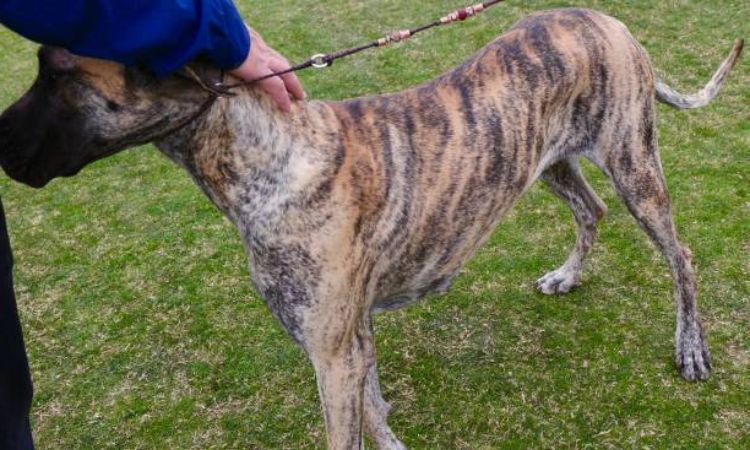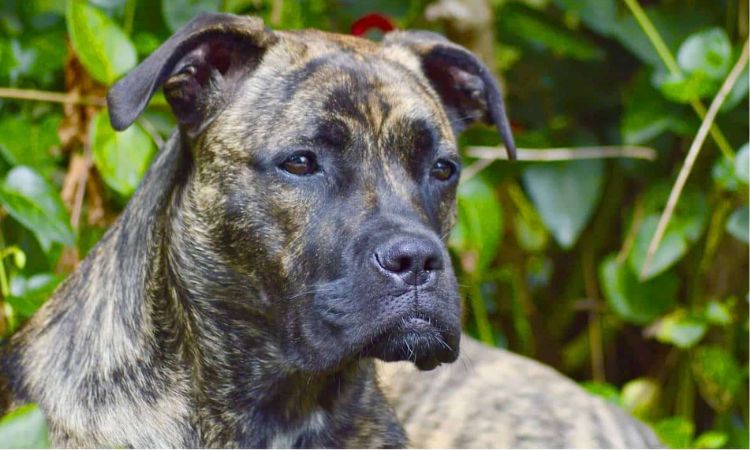The Alano Español, or Spanish Bulldog, is a striking breed known for its strength, intelligence, and loyalty. With a history stretching back centuries, these dogs were once trusted companions in hunting, cattle herding, and even bullfighting. Athletic yet deeply devoted, the Alano Español is as capable in the field as it is loving at home, making it a breed that captures attention and admiration wherever it goes.
History of Alano Español
The Alano Español, also known as the Spanish Bulldog or Alano Montero Español, is an ancient molosser-type breed whose origins date back over 1,500 years. Historians believe the breed descends from the alaunt dogs brought to Europe by the Alans, a nomadic people from Central Asia, during their migrations around the 4th and 5th centuries. These dogs were robust, versatile, and bred for war, hunting, and livestock management. In Spain, the Alano developed into a powerful working dog, capable of controlling cattle, hunting large game, and even participating in battles. Through careful selection over centuries, it evolved into a medium-to-large, athletic, and functional dog with exceptional strength, endurance, and courage.

The Alano Español has been deeply intertwined with Spanish culture and rural life. During the Middle Ages, kings such as Alfonso XI referenced these dogs in hunting manuals like the Libro de la Montería, praising their strength, bravery, and instinctive grip. The breed played a crucial role in handling half-wild cattle, hunting wild boar, and even participating in bullfighting events before the practice was banned in the late 19th century. Historical records, paintings by masters like Velázquez and Goya, and literary mentions by authors such as Cervantes and Lope de Vega illustrate the Alano’s presence and importance in Spanish society. Its combination of fearlessness, intelligence, and loyalty made it a prized companion of hunters, farmers, and soldiers alike.
Over the centuries, the Alano Español faced periods of both prominence and decline. Its strong functional focus meant it was never bred primarily for appearance, which helped maintain its physical and mental resilience. However, the decline of traditional bullfighting, changes in livestock practices, and the import of other dog breeds in the 19th and early 20th centuries brought the breed to the brink of extinction. Fortunately, dedicated breeders in northern Spain preserved isolated populations, particularly in the Encartaciones Valley and Valle de Mena. By the 1980s, breed recovery programs analyzed DNA and carefully selected the healthiest, most functional dogs to restore the Alano Español. Today, the breed continues to embody its historical traits—strength, agility, courage, and loyalty—making it not only a living piece of Spanish heritage but also a versatile working dog and cherished companion.
Alano Español Temperament and Personality
Characteristic Traits
Fearless and Confident
Alano Españols are remarkably brave dogs. They possess exceptional courage and a high tolerance for pain, qualities that historically allowed them to hunt large game and participate in demanding labor. Their serious, noble expression mirrors their inner strength and determination, making them appear naturally dominant yet composed.
Loyal and Devoted
These dogs are intensely loyal to their owners and families. They are fiercely protective of their home and loved ones, often placing themselves between danger and those they care about. This devotion makes them excellent watchdogs without being unnecessarily aggressive.
Quiet Guardians
Alano Españols are observant and watchful, often monitoring their surroundings silently. Unlike many large breeds, they rarely bark without cause, relying on vigilance rather than noise to alert their owners. This quiet demeanor reflects their thoughtful, controlled nature.
Family and Social Dynamics
With Owners
Alano Españols form strong bonds with their families. They are affectionate, patient, and submissive within their inner circle, showing a gentle demeanor especially around children. Due to their size and strength, supervision is recommended around younger kids, but their natural calmness and protective instincts make them excellent companions.
With Strangers
While loving toward their owners, Alano Españols are naturally wary of strangers. They maintain a cautious distance until the visitor is fully accepted, reflecting their protective instincts. This reserved nature is a hallmark of the breed and reinforces their role as loyal guardians.
With Other Dogs
Historically bred to work in packs, Alano Españols typically get along well with other dogs if socialized early. However, their dominant personality means they will not back down from a challenge, and they can assert themselves when necessary. Early and consistent socialization is key to fostering harmonious interactions with other animals.

Training and Socialization Needs
Not a Novice Dog
Alano Españols are best suited for experienced handlers. Their natural dominance requires a firm, consistent owner who can establish clear leadership while respecting the dog’s intelligence and instincts. Without proper guidance, they may test boundaries, which can be challenging given their size and strength.
Early Socialization
Introducing the Alano Español to a variety of people, animals, and environments from a young age is crucial. Early socialization helps manage their protective instincts, reduces undue aloofness toward strangers, and builds confidence in varied situations.
Trainability
Intelligent and obedient, Alano Españols respond well to structured training. Positive reinforcement works best, combined with clear rules and consistent expectations. Their dominant nature requires patience and skill, but with the right guidance, they become highly loyal, well-behaved, and versatile companions.
Alano Español Price and Cost of Ownership
Initial Puppy Price
The Alano Español is a rare and highly sought-after breed, which is reflected in its purchase price. Several factors influence the cost of an Alano Español puppy:
- Breeder Reputation: Puppies from well-established breeders who follow strict breeding standards and health testing tend to be more expensive. Reputable breeders ensure proper socialization, vaccination, and early training.
- Lineage and Pedigree: Dogs from strong working lines, or those with ancestors holding hunting or guard dog titles, generally command higher prices.
- Location: Availability is limited outside of Spain. Importing a puppy internationally can significantly increase the cost due to travel, quarantine, and shipping fees.
- Rarity: Since the breed is uncommon and many kennel clubs (including the AKC and FCI) do not officially recognize it, Alano Español puppies are considered premium and can range anywhere from $600 to $2,000 USD, depending on the factors above.
Comparison to Other Breeds: Compared to other Molosser-type or large working breeds, such as the Dogo Canario, Mastín Español, or even American Bulldogs, the Alano Español can be similarly expensive or slightly higher due to its scarcity and historical significance.
Ongoing Expenses
Owning an Alano Español requires a long-term commitment, both financially and in terms of time and care. Some of the key ongoing costs include:
- Food: As a large, active, and muscular breed, Alano Españols require a high-quality diet tailored to large breeds. This includes nutrient-dense dry kibble or premium dog food with balanced protein, fat, and vitamins. Adult dogs may consume several cups of food daily, depending on activity level, which can cost $80–$150 per month.
- Veterinary Care: Routine veterinary expenses include annual checkups, vaccinations, flea/tick prevention, heartworm prevention, and dental care. Large breeds may also benefit from joint supplements to support hip and elbow health, and preventive care can cost $500–$1,000 per year.
- Insurance and Miscellaneous Costs: Pet insurance is recommended for large breeds due to potential health risks, though Alano Españols are generally hardy. Additional costs include toys, leashes, training tools, bedding, and grooming supplies. Investing in proper training classes is also strongly advised, especially for first-time owners handling a dominant and intelligent breed.
Care, Health, and Maintenance
Exercise Requirements
The Spanish Alano is a high-energy working breed that requires significant daily physical and mental stimulation. Ideally, they should engage in 1–2 hours of vigorous activity each day, which can include long walks, running in open spaces, or structured play and training sessions.
This breed thrives in rural or suburban settings where they have room to move freely. While they can adapt to indoor life, apartment living is generally not recommended, as insufficient exercise may lead to restlessness, boredom, or behavioral issues. Active owners who can commit to daily outdoor activity and mental enrichment are the most suitable companions for this breed.
Grooming
Spanish Alanos have a short, smooth coat that makes grooming straightforward and low-maintenance. Key points include:
- Brushing: Occasional brushing is sufficient to remove dead hair and keep the coat healthy and shiny.
- Bathing: Bathe as needed, typically once a month, or after heavy outdoor activity.
- Ears and Nails: Routine ear cleaning and nail trimming are essential to prevent infections or overgrowth.
- Drooling: Unlike many Molosser breeds, the Spanish Alano is not prone to drooling, making it a cleaner option for indoor living compared to other large breeds.

Health Concerns
The Spanish Alano is generally a hardy and robust breed, reflecting its history as a functional working dog. However, as with most large breeds, there are some potential health considerations to be aware of:
- Hip and Elbow Dysplasia: Common in many large breeds, so monitoring joint health and providing appropriate nutrition is important.
- Bloat (Gastric Dilatation-Volvulus): A risk in deep-chested dogs; feeding smaller, frequent meals and avoiding vigorous activity immediately after eating can reduce risk.
- General Health: This ancient breed was historically selected for function and resilience, making them less prone to hereditary issues compared to some modern breeds.
Reputable Breeders: To ensure a healthy Spanish Alano, acquire puppies from certified breeders who perform health testing on breeding stock, including hips, elbows, and heart evaluations. Proper screening helps reduce the risk of inherited conditions and ensures a strong foundation for a long, healthy life.
The Alano Español stands out as a rare, powerful, and intelligent breed, combining centuries of history with unmatched loyalty and protective instincts. Owning one requires experience, commitment, and space, but in return, you gain a steadfast companion, a vigilant guardian, and a dog with remarkable endurance and character. From their carefully preserved lineage to their unique temperament, every aspect of the Alano Español reflects a breed built for strength, devotion, and versatility. For those prepared to meet its needs, this breed offers a lifelong partnership that is as rewarding as it is extraordinary.






